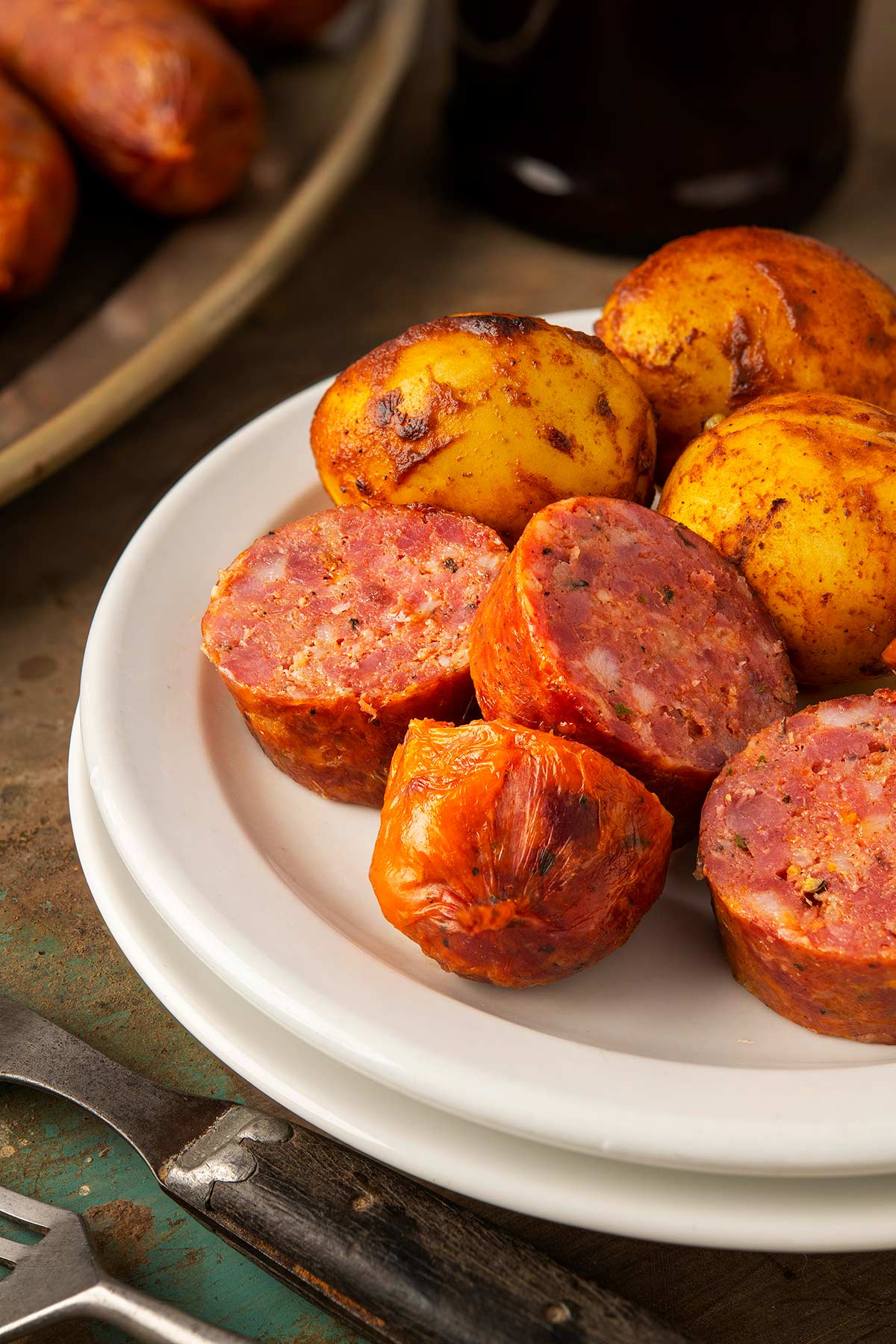As an Amazon Associate I earn from qualifying purchases.
If you’ve ever had Texas barbecue, chances are you’ve had hot links; they are almost a requirement at most Hill Country BBQ joints. Here’s how to make them at home.

There are several versions of hot links sausage, depending on where you are from. Growing up, to me hot links were a sort of hot dog, obviously a spicy one.
Louisiana makes a hot link, too, which is kinda-sorta similar to andouille, but spicier. This recipe is for the standard Texas hot links you’ll see pretty much everywhere in the Lone Star State — except for east Texas, where hot links are short, fat links that are purposely mushy inside, a bit like boudin.
(Incidentally, there is another common sausage in Hill Country that is very simply known as “sausage,” and it’s an all-beef link flavored with garlic and black pepper. Smitty’s in Lockhart makes a good one.)
Most hot links wherever you find them are either pork, beef or a combination. I took that route and made pork and venison sausages.
Interestingly, most Texas hot links I’ve eaten weren’t terribly hot. Some use cayenne and paprika to give them a red hue (mine does), and others just use cayenne. But it’s always a mild, pleasing heat.
That’s not to say you can’t amp things up to suit your tastes. I am sure some Texans somewhere use ghost peppers or Carolina reapers or somesuch in their recipes, but I’ll pass.

Tips on Making the Sausage
If you’re not already familiar with sausage making, here is a comprehensive tutorial on making sausage.
Generally speaking, this should be a coarse sausage, ground twice. But you can grind finer if you want. I will grind once with a medium die, 6 or 7 mm, and then sometimes I’ll grind some of that through a finer, 4.5 mm die. This gives the sausage a more interesting consistency.
For the liquid, I use something like Lone Star beer or a Mexican lager like Modelo or Carta Blanca, but you could use ice water, too.
Regular hog casings will work fine, but I’ve seen hot links range from skinny to weirdly fat; those would be the east Texas stubby links.
Smoking Hot Links
This is a smoked sausage, so you’ll need a smoker. Any will do, but you will want to smoke these links to an internal temperature of about 150°F, getting there over the course of a few hours. For me, that means smoking at about 180°F for three hours.
Wood choice is up to you, but since these are Texas hot links, I prefer either oak or mesquite.
Serving Hot Links
I generally eat hot links as is as part of a barbecue spread, along with brisket, barbecued chicken, barbecued pork shoulder, potato salad, cole slaw, pickles and, if you want to be super authentic, Texas toast, which is a heavier, thicker cut white bread.
You can also put them in gumbo or jambalaya, and they make a good stand-in for spicy Italian sausage in a pasta sauce or for sausage, peppers and onions — although if you know you are planning on using them for this, don’t smoke the sausages.
They are also good in place of linguica in a Portuguese kale soup.
Storing and Preserving
The general rhythm is that you make hot links, smoke them, then either eat them right away or plunge them into cold water to stop the cooking and then eat them later.
What this means is that the sausages will be heat-and-eat, whether it’s the next day or months later. Pretty convenient. Texas hot links will keep a week in the fridge and a year in the freezer if you vacuum seal them.
Texas Hot Links
Ingredients
- 3 pounds venison
- 2 pounds fatty pork shoulder, or belly
- 34 grams salt, a little less than 2 tablespoons
- 5 grams Instacure no. 1, a little less than a teaspoon (optional)
- 1 tablespoon sugar (optional)
- 2 tablespoons paprika
- 1 tablespoon freshly ground black pepper
- 1 tablespoon cayenne
- 2 teaspoons thyme
- 6 bay leaves, ground fine
- 3 cloves garlic, minced
- 1/3 cup lager beer, or ice water
- Hog casings
Instructions
- Cut the venison and pork into chunks that will fit into your grinder. Mix well with the salt and sugar. Let this sit in the fridge for as long as you can stand, up to overnight if you have time; it helps the sausage bind to itself better.
- Get out about 10 to 15 feet of hog casings and soak them in warm water.
- Mix the spices and garlic with the meat and fat and grind though a coarse die, about 10 mm. If you don't have that, grind with as coarse a die as you have. If your room is warmer than about 70°F, grind into a container that is set in ice, to keep things very cold.
- If the meat is still below 40°F, go ahead and grind again through a 6 mm die or similar. TIP: If you have some bread around, rip off a piece and make that the last thing in the grinder: It pushes out all of the rest of the meat so you don't waste any. If the meat is above 40°F, put it in the freezer for 30 minutes while you clean up everything.
- Add the beer (or water) to the sausage mixer and mix well with your (clean) hands, or a mixer with a paddle attachment set on low, for about 2 minutes. The sausage will adhere to itself and you will see whitish streaks in the bowl. Put the sausage in a sausage stuffer.
- Thread a casing onto the stuffer, leaving a few inches as a "tail" so you can tie it off later. Stuff the whole casing at once, again leaving a tail at the other end. Repeat until you've stuffed all the sausage.
- Make links by pinching them off and spinning them, first one way, then the other. This prevents them from unraveling when you hang the links to dry. You can also tie them off with twine. Here's a quick video on making the links. Tie off the ends of the casings.
- Carefully compress the links to reveal air pockets, and prick the links with a needle to remove them, gently compressing the meat.
- Hang your sausages to dry, for an hour at room temperature, or up to a day if you can do so in 40°F or below.
- Smoke your hot links at 200°F or thereabouts until they reach about 150°F internal temperature. Then, either eat them or plunge them into a bath of ice water to stop the cooking. Dry them off and store in the fridge for a week, or freeze.
Notes
Nutrition
Nutrition information is automatically calculated, so should only be used as an approximation.






Could you
Use ground beef instead of venison? Or will that take away from the taste?
D: You can use beef, but sausages are a whole lot better when you grind the meat, salt, fat and spices together. That said, I imagine you could make an ok version with pre-ground beef. It will be too lean, though. Sausages are normally 20% + fat, where ground meat is almost always 15% or less.
These turned out great we cooked and ate them like Maxwell Street Polish sausages, caramelize onions, peppers sauerkraut and mustard of your choosing. They didn’t get a huge smoke flavor I’m guessing the salt packed casings didn’t let the smoke in????
I’m getting ready to do about 50lbs of this sausage, I have a lot of deer meat. That said, how would it work to vacuum seal and freeze fresh so I have versatility? Smoke them when I take out to eat if that how I want them or use fresh in other recipes if that’s how we want them?
Thanks!
Jared
Jared: That’ll work.
Thank you! Would I leave out the instacure #1 in that case or use it anyway?
Made the 50lbs as planned and they are delicious! I used the meat binder and I like the texture of the sausage. Used natural pork casing as always. The casing is so tough after smoking it really takes away from the quality in my opinion. Did I get a bad batch of casings or does the meat binder have something to do with it?
Thanks!
Jared
Hank,
Using pecan and cherry splits, I smoked these yesterday hanging in the warming chamber, at 185 deg F, of my reverse flow offset horizontal cooker while a brisket was cooking in the main chamber at 300 deg F. The sausages took about 2.5 hours to cook, pulled them at 150 deg F internal, and then cooled in an ice bath. Finally, the sausages were finished off on a grill at an outdoor movie-night party where they were well received by guests and none came home with me, unlike my smoked neck bones and cabbage dish. The spice heat was noticeable and went well with cold beer. I used a beef tri-tip roast, from a local grocery store bargain bin, as I did not have any remaining venison in the freezer. A binder was not used in the mix and my wife commented “that the texture was very good”; I used 10/6 mm plates for the double grind. Nice formula, I will definitely make these sausages again on future cooks, but with upcoming fresh venison!
Very tasty! For the paprika, I went 1 TBS hot Hungarian and 1 TBS smoked. For me, I would bump up the cayenne by another tsp or so for a touch more heat, but overall super easy and tasty. Using 3# venison and 2# pork I ended with 32 links (only 30 of which made it to the vacuum sealer!
Thanks for putting these recipes in line for us, Hank.
I have had excellent results using rusk in my Irish bangers. Would this work well in these as far as creating a softer texture?
Shawn: You can try it. Adding grain isn’t traditional in this sausage, though.
Excellent recipe! I added jalepeno powder,high temp cheddar and a good amount of serrano peppers. They were nice and spicy!!
I made these and love the taste, but the pork casings became somewhat tough and chewy. I followed the smoking and ice water cooling instructions closely and used salted, refrigerated casings from sausagemaker.com. Can anyone tell me what happened?
Richard: That’s basically how it is. There is supposed to be snap in the casing. You didn’t do anything wrong, but since casings are a natural product, sometimes that snap can shift over into tough. My best guess when this happens is that the casings were from an older pig.
This recipe looks amazing. I am planning to make it with some lean venison stew meat. I also have some back fat I plan to use instead of shoulder. Would going about 20% work or would you recommend using shoulder for the added flavor from the meat?
Looks like nice , well proportioned recipe. Nice to to see that it does not include the non “fat dry skim milk powder” that many hot link recipes do. Most people think that it’s the instant stuff you buy at the grocery store, but it’s not. I just wish you would present your recipes in metric measurements or percentages rather than by volumes. Most us home sausage makers are not 95 year old grandmothers.
I made a 10 lb batch of this over the weekend. Used 50% lean venison and 50% pork shoulder. I added some nonfat dry milk as a binder (bit over a cup, all I had), cold smoked at 120 degrees for a couple of hours, then put in sous vide to bring up to IT of 150 degrees. Ice bath, then hung to bloom for a few hours before vacuum sealing and freezing. Came out really good – warm but not hot.
I made a little over 30 pounds of this last week. They turned out great (excepting some issues I had in linking-but that’s on me and not the recipe).
I used 18 pounds of fat and lean from a feral hog, nine pounds of venison and 3 pounds of domestic hog fat along with every bay leaf I had in the house.
Thank you for the recipe and idea!!
Next up is using the polish duck sausage recipe with venison…
Hank, did you use fresh or frozen venison? Which cut? Stew meat? Hamburger grind?
Richie: I used thawed venison. Stew meat.
The sausage sounds great. I’ll definitely make it. I strangely need to know about the eggs in the photo. What’s going on there?
Jordan: Ha! They are chile-roasted potatoes.
Hey Hank. Thanks for the recipe and inspiration. For the more experienced sausage makers, would you mind clarifying your cure values in terms of percentages as well? I see 1.5% salt & appx. 0.25% pink salt, but what’s the sugar value?
Thanks!
Tennessee: Sugar percentage is simply for flavor, so it need not be as precise. I add it to give the links a vague sweet back note to go with the savory and spicy. You can even leave it out if you want.
How much binder is used for 5lbs.
Robert: Not much, but you will need to follow the directions on the specific binder you get. If you’re talking about the Butcher and Packer binder, it’s on the package.
Hank,
Greetings from Hill country. Central Texas sausage (and all the way down to Houston)is called hot guts, or just sausage, not hot links. Primary seasonings are lots of garlic and black pepper, and they are 100% beef. Stellar examples are the sausages at Myers in Elgin, and Southside market located in Elgin and also Bastrop. You listed a good recipe, it’s just not Texan.
Matthew: It is 100 percent Texan since I adapted it from a barbecue guy in Bastrop. It’s just not your recipe. And I am well familiar with the sausages you mention. Smitty’s in Lockhart has a great one like that.
🙂
Texans are proud, and rightly so.
This sausage will be the the next recipe I attempt.
Thanks.
— Paul
(English transplant-25 years in TEXAS!)
I find that if I set the smoker( a commercial unit from P.S. Seasonings) above 180, the protein and fat in the sausage begin to separate. I also use cure #1, at a rate of 4 oz. per 100 lbs. Or f using a digital scale ..06 for 25lbs. This recipe sounds great, can’t wait to try it!
Hi Hank, I noticed you did not use Prague powder #1 in this recipe. Not a problem to omit it? Thanks
Mike: You can use it, for sure. Use about 5 grams of cure for this batch.
Hello – I am going to make this recipe and have a question about what type of salt you used?
Kathy: Any regular salt, i.e., kosher or sea salt, will work. You want to avoid table salt, which has anti caking additives, or odd salts like black or red or pink ones. Generally speaking you want a fine-cut salt, too. I personally use Diamond Crystal kosher salt.
Thank you for this recipe. It will be so much more useful and easier for your followers if you start introducing percent recipes based on weight of meet as 100%. Even just to put it in parentheses for start.
Milos: Actually no. I used to do that and the majority of my readers hated it. Sorry.